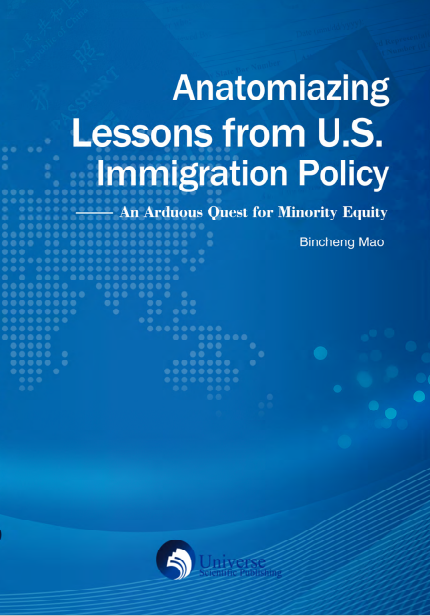Brief
In the past few hundred years, the United States has been indirectly affected by a large number of immigrant groups with diverse sources, among which Asian immigrants are growing fastest. At the end of the century, Asian Americans are quietly emerging as one of the largest ethnic groups in the United States. In the process of immigration legislation, it is necessary to draw lessons from the U.S. Immigration Act, because after all, the United States is one of the largest immigration importing countries in the world, and its immigration law is relatively perfect. From the colonial era to the era of the knowledge economy, foreign immigrants are closely related to the social development of the United States for more than 200 years. Therefore, immigration policy has become an important aspect of the social operation mechanism of the United States. There are many industries in American society that rely on immigrants to support, for example: "nearly 47% of the labor force in agriculture is immigrants, and immigrants from other industries, such as scientific research, computers, services, etc., also account for a considerable proportion. every year hundreds of thousands of people come to the United States to seek freedom, opportunity and happiness" [1]. Judging from the domestic literature, there is quite a lack of research on the intercultural pressure and mental health of Chinese immigrants in the United States. Most of the research related to this has been done abroad, especially in the United States, mainly focusing on the study of cultural adaptation, its influencing factors and coping ways.
This paper studies the influence of the adjustment and change of the U.S. immigration policy and immigration law on Indian immigrants since the founding of the People's Republic of China, that is, based on the current problem of Indian immigrants to the United States, making the study of this problem of practical significance. The limited personal resources, social contacts and social networks of Chinese immigrants in the United States, their less proficient English and geographical changes will make adaptation difficult. These factors will lead to significant stress and endanger their mental health. The legal and social system in the United States seems perfect and developed, but it is still far from perfect. Especially in dealing with immigrants, there are still serious human rights problems. This paper systematically examines the evolution of U.S. immigration laws and policies and their impact on Indian immigrants, especially focusing on the dual influence of U.S. Indians on the U.S. and India, thus making up for the deficiencies in this field to some extent. This article tries to discuss the inseparable relationship between immigrants and this country, trying to explain that immigrants have been playing an irreplaceable important role in this country.
Catalog
Directory
1. Introduction................................................................................................... 1
2. An Analysis of the Motivation of American Immigration Policy..............3
2.1. The establishment of a nation-building ideology to encourage immigrants....................................................................................................3
2.2. Economic motivation is paramount.......................................................6
2.3. Racism started making waves............................................................... 8
2.4. The political motivation is very prominent......................................... 12
2.5. Both political and economic motives are important............................15
3. Changes in US Immigration Policy............................................................18
3.1. The policy of free immigration dominated by British people in the colonial era before the independence of the United States.........................18
3.2. The indecisive immigration policy of the United States since its independence.............................................................................................. 19
3.3. A free and open immigration policy....................................................20
3.4. The immigration policy of severe exclusion, severe restriction and choice..........................................................................................................22
3.5. An immigration policy that is gradually loosening its restrictions..... 24
3.6. Immigration policy that takes into account the needs of national security and economic development.......................................................... 25
4. Trends in American Immigration..............................................................27
4.1. Free immigration period......................................................................27
4.2. Restriction and selection phase........................................................... 29
4.3. Exclusion and restriction period..........................................................32
5. An Analysis of the Reasons for the Evolution of American Immigration Policy.................................................................................................................35
5.1. The inherent requirements of the U.S. economic development process. .................................................................................................................... 35
5.2. The controversy over the role of immigrants...................................... 38
5.3. American social liberalism..................................................................40
6. Alien Cultural Pressure of American Immigrants...................................43
6.1. The research origin and concept development of cultural adaptation.43
6.2. Research on the process of cultural adaptation................................... 45
6.3. Research on cultural background and cultural adaptation...................48
6.4. The theory and research of cultural adaptation................................... 51
6.5. Theoretical research on intercultural pressure.....................................56
6.6. Different cultural stressors and coping strategies................................61
7. The Adjustment of American Immigration Policy and Its Impact.........64
7.1. The adjustment and change of U.S. immigration policy and immigration law......................................................................................... 64
7.2. The reason why India immigrated less in the early 20th century........68
8. Immigrants' Success in Political and Economic Fields............................73
8.1. Comparison with other immigrant groups...........................................73
8.2. The economic achievements of immigrants........................................75
8.3. The political influence of immigrants................................................. 78
References........................................................................................................ 82
Author
Bincheng Mao is an undergraduate student at New York University where he studies history and politics. Bincheng currently serves as the president of the East Coast Coalition for Tolerance and Non-Discrimination (ECC), dedicated to promote social inclusion for minorities.
In 2018, Bincheng ’s editorial piece on the injustice of the guardianship system in Saudi Arabia was awarded the national runner-up of the New York Times Fifth Annual Editorial Contest. In 2019, Bincheng ’s research paper on Henry Kissinger’s peace-keeping theory was shortlisted by John Locke Institute (University of Oxford and Princeton University) as one of the best papers in the history category of its annual essay competition.
Cip
National Library Board, Singapore Cataloguing in Publication Data
Name(s): Mao, Bincheng.
Title: Anatomizing lessons from U.S. immigration policy : an arduous quest minority equity / Bincheng Mao.
Description: First edition. | Singapore : Universe Scientific Publishing, 2020. | Includes bibliographical references.
Identifier(s): OCN 1151359043 | ISBN 978-981-14-5642-8 (paperback)
Subject(s): LCSH: United States--Emigration and immigration--Government policy. | Emigration and immigration law--United States. | Immigrants--
United States. | East Indians--United States.
Classification: DDC 325.73--dc23
